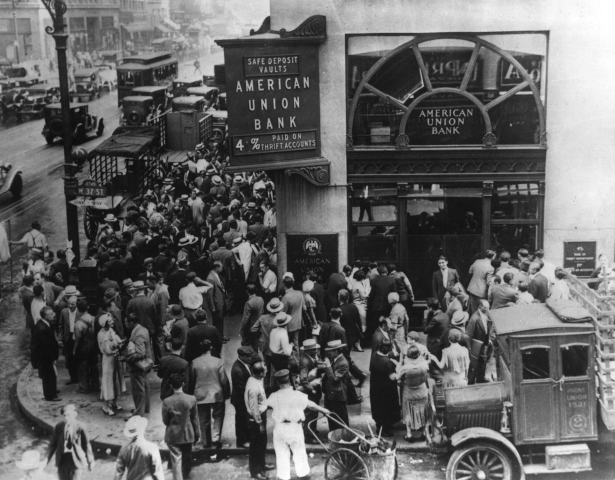
What caused the Great Depression? There are many causes. Some of them are the investment bubble, the Wall Street Crash, the credit boom, the collapse of world trade due to the Smoot-Hawley Tariff, bank failures, and the gold standard. Let’s look at these.
First, what exactly was the Great Depression? In begin in 1929, the Wall Street Crash on October 24th is often given as a starting date, and lasted until 1933. It affected most of the countries in the world and sparked depressions. It harmed global trade, reduced GDPs, caused sky high unemployment, and wasn’t completely fixed until the beginning of World War 2. The rearmament and mass conscription of World War 2 fixed the economies and brought unemployment down.
So, what caused it? The first cause is the investment bubble and the reliance on credit that built up through the 1920s. After World War 1, the USA was going through a period of boom. The war had introduced new technologies and the economy was getting stronger. A lot of companies started offering shares to get access to investment capital and, for possibly the first time, it became relatively easy for people to buy these stocks. To help them, a lot of banks started to lend people money more freely than they had before. This money was for things like cars and houses, but it was also to buy stocks. Borrowing money to buy shares can be risky, but there was a method called “on margin”, where people could buy shares with money borrowed against future share prices. The market kept going up, until it didn’t. Everything crashed in October, with the 24th to 29th of October period being known as Black Thursday, Black Monday, and Black Tuesday. The Wall Street Crash ruined investors, but it was not inevitable that it would become a great recession or that it would spread around the world.
The second cause of the Great Depression were the bank failures. When people borrow money to buy shares and the price drops, they can end up owing a lot of money, which they probably cannot pay. If a lot of people default on their loans, the banks will end up with a shortfall of money. This can spark a panic where people want to get their money out of the banks and the banks don’t have enough capital to cover it. A bank can manage if regular people try to take out their money. It is when larger corporations or other banks try to withdraw money that banks begin to fail. In the US alone, over 9,000 banks failed during the Great Depression. If banks fail, the economy stalls because there is no money to go around. People worry that they will lose their savings, so they stop buying risky items like cars, and just buy the necessities.
The Great Depression began to go worldwide because America is a very important importer and exporter in the world. If the American economy is suffering, they stop buying goods from other countries, which makes their economies suffer as well. Banks began to fail across Europe as they entered into depressions. This was all made worse by the Smoot-Hayley Tariff, which was introduced in 1930. In the beginnings of the Great Depression, people thought it was important to protect American jobs and farmers from foreign competition. The Smoot-Hayley Tariff was introduced to raise tariffs on foreign imports into the USA. Over 20,000 imports were affected. Some tariffs went up to 60%. Other countries were very angry at the tariffs and they introduced their own in retaliation. Global trade became very expensive and all but ground to a halt. Trade had become so globalized by that point that halting trade caused economic chaos in all countries across the world.
The last cause was the gold standard. Money has always been pegged to something valuable because it was basically a promissory note. The paper was not worth anything, it was only worth the valuable thing you could exchange the note for. Over time, money became pegged to gold because gold was the most valuable thing. The gold standard was the system where gold had the same value in any country so all countries needed to peg their currencies to gold. The currency went up or down if the price of gold went up or down. Trade was easy because it could all be set on the rate of gold, but it meant countries didn’t have the power to print money and alter their own economies. A country needed to back up its currency with gold and it could only be as rich as the amount of gold it had. This became a problem when the Great Depression hit because Americans started to sell dollars and buy gold because it was safer, which drove the price of the dollar down. That meant the USA had a trade surplus because US goods became cheap and other countries were using their gold to buy from the USA, which meant more gold was arriving in the US, driving down the economies of other countries. Different countries increased interest rates to protect their currencies, which forced companies to close, increased unemployment, and worsened the whole depression. Countries began to leave the gold standard from 1931 so they could more easily control their own currencies. Without all of these things, the Great Depression may not have spread around the world.
Image By National Archives Photo – Social Security History Site, Public Domain, https://commons.wikimedia.org/w/index.php?curid=374093
Sources
https://www.history.com/news/great-depression-causes
https://www.britannica.com/story/causes-of-the-great-depression
https://www.investopedia.com/ask/answers/09/gold-standard.asp
https://en.wikipedia.org/wiki/Smoot%E2%80%93Hawley_Tariff_Act
